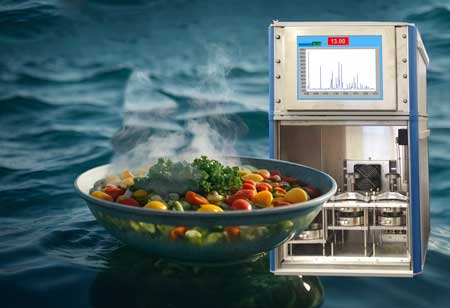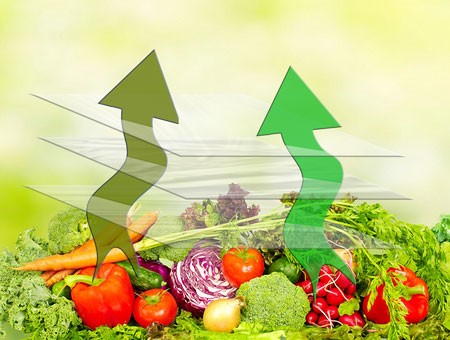Food and vapour permeability - considerations
 Vapour permeability, particularly water vapour, plays a significant role in the food industry, especially in food packaging, storage and processing. Proper management of vapour permeability is essential to preserve food quality, extend shelf life, prevent spoilage and maintain product safety. Below is a detailed look at the role of vapour permeability in various aspects of the food industry:
Vapour permeability, particularly water vapour, plays a significant role in the food industry, especially in food packaging, storage and processing. Proper management of vapour permeability is essential to preserve food quality, extend shelf life, prevent spoilage and maintain product safety. Below is a detailed look at the role of vapour permeability in various aspects of the food industry:
For more food packaging materials, their vapour permeability properties and applications click here
1. Food Packaging
Water vapour transmission rate (WVTR / MVTR), or vapour permeability, is a critical parameter in food packaging. The ability of packaging materials to either block or allow the transmission of water vapour significantly impacts food shelf life and quality. Key areas where vapour permeability is important include:
- Moisture-Sensitive Products: Many food products, such as dry snacks, cereals, or powdered goods, must be protected from moisture ingress. Packaging with low water vapour permeability helps keep these products dry, preventing clumping, spoilage, or loss of texture.
- Fresh Produce and Breathability: Fresh fruits and vegetables require packaging materials that allow some degree of vapour permeability to manage respiration. Produce continues to respire after harvesting, releasing water vapour and gases like CO₂. Packaging materials must allow excess moisture to escape to prevent condensation and mould growth while also maintaining the right level of humidity to keep the produce fresh.
- High-Moisture Foods: For high-moisture products like cheeses, meats, or ready-to-eat meals, packaging needs to prevent moisture loss to avoid drying out or degradation. In this case, low vapour permeability materials are used to retain moisture and prevent the product from losing its original texture and flavour.
- Modified Atmosphere Packaging (MAP): Vapour permeability plays a crucial role in MAP, where food is packaged in an atmosphere with controlled levels of oxygen, carbon dioxide, and nitrogen. The packaging must maintain a specific permeability to water vapour and gases to maintain the right balance of moisture and prevent condensation, which could spoil the food.
2. Shelf-Life Extension
- Prevention of Dehydration: For products that require a specific moisture level (such as bakery items, cakes, or soft cheeses), packaging with optimized vapour permeability prevents dehydration, ensuring the product retains its intended texture and taste. Proper moisture control extends the shelf life by maintaining the food’s quality.
- Oxidation and Mould Prevention: Vapour permeability is also essential in protecting against oxidation and mould growth. Foods that are exposed to too much moisture can spoil rapidly due to microbial growth. Packaging materials with low vapour permeability help create a barrier against moisture, reducing the risk of mould, bacteria, or yeast proliferation.
 3. Controlled Atmosphere in Storage and Transportation
3. Controlled Atmosphere in Storage and Transportation
- Cold Storage and Refrigeration: In cold storage, vapour permeability is important for controlling humidity levels. If packaging allows too much moisture in, products can suffer from freezer burn, frost accumulation, or moisture loss. Packaging with proper vapour barrier properties ensures that the food remains intact during storage and transportation.
- Frozen Foods: In the frozen food industry, managing vapour permeability helps prevent the formation of ice crystals on food surfaces, which can lead to freezer burn and negatively affect food quality, texture, and flavours. Packaging materials with low vapour permeability protect the food from moisture migration during freezing and thawing cycles.
4. Food Processing
- Drying and Dehydration: In food processing, especially in dehydrated products (such as dried fruits, vegetables, or jerky), controlling vapour permeability is essential to achieve the desired moisture content. In drying processes, packaging with high vapour permeability is used to allow moisture to escape from the product, ensuring proper dehydration without trapping excess moisture.
- Fermentation: Vapour permeability is crucial in the production of fermented foods (such as yogurt, kimchi, or sauerkraut). In these processes, packaging must allow gases to escape while preventing excess moisture from entering. This balance is important to maintain the fermentation environment while preventing spoilage.
- Moisture-Absorbent Packaging: In some cases, packaging includes moisture-absorbent materials (e.g., sachets or films) to control the internal moisture environment within the packaging, allowing for optimal preservation of food.
5. Environmental Impact and Sustainability
- Biodegradable and Compostable Packaging: As the food industry shifts towards more sustainable packaging solutions, materials such as biodegradable or compostable films are becoming more common. These materials often have different vapour permeability characteristics compared to traditional plastics. Managing vapour permeability in these new materials is crucial to ensuring they perform well while still offering the environmental benefits of biodegradability.
- Recycling Concerns: When packaging materials with specific vapour permeability are designed for recycling, their permeability properties must be balanced with their ability to be processed and reused in a way that doesn’t compromise food safety or packaging integrity.
6. Applications in Specific Food Categories
- Baked Goods: Breads, pastries, and cakes are highly sensitive to both moisture loss and gain. If too much moisture escapes from the packaging, these products become stale; if too much moisture enters, they become soggy. Packaging with optimized vapour permeability helps maintain the right moisture balance.
- Snacks (e.g., Crisps (US Chips), Crackers): Packaging for crispy snacks must have low vapour permeability to prevent the absorption of moisture, which would make the products lose their crunch and freshness.
- Meat and Fish: For fresh or processed meat products, packaging must maintain moisture levels without allowing too much water vapour to escape as this can cause drying out or freezer burn in frozen products. At the same time, excess moisture inside the package can lead to microbial growth, so the right balance of vapour permeability is critical.
- Dairy Products: Dairy items like butter, yogurt, and cheese require careful control of water vapour and oxygen permeability. For cheeses, vapour-permeable materials may be used to allow gases to escape during ripening while preventing unwanted moisture loss or ingress.
 7. Active and Intelligent Packaging
7. Active and Intelligent Packaging
- Moisture Control: Some active packaging solutions include moisture-absorbing materials that help regulate the humidity level inside the packaging. This enhances the effectiveness of vapour-permeable materials by actively controlling the moisture content, keeping the food fresh for longer.
- Sensor-Integrated Packaging: Intelligent packaging may use sensors that respond to moisture changes, offering visual indicators (e.g., color change) if moisture levels inside the package become too high or too low, signaling potential spoilage or quality loss.
Key Considerations for Food Industry Professionals
- Choosing the Right Material: Selecting packaging materials with the appropriate vapour permeability is critical to ensuring food safety and quality. Materials like polyethylene, polypropylene, polyamide, and coated films all have varying degrees of vapour permeability that are tailored to specific food products.
- Balancing Barrier Properties: Often, packaging must balance vapour permeability with other properties like oxygen permeability and mechanical strength to meet the specific needs of the food product and its storage conditions.
In summary, vapour permeability is essential in the food industry for preserving product quality, preventing spoilage, and extending shelf life. By managing how much water vapour can enter or escape from a package, food manufacturers can ensure that products maintain their intended texture, flavours, and safety, from production through to the point of consumption.
| |


 Vapour permeability, particularly water vapour, plays a significant role in the food industry, especially in food packaging, storage and processing. Proper management of vapour permeability is essential to preserve food quality, extend shelf life, prevent spoilage and maintain product safety. Below is a detailed look at the role of vapour permeability in various aspects of the food industry:
Vapour permeability, particularly water vapour, plays a significant role in the food industry, especially in food packaging, storage and processing. Proper management of vapour permeability is essential to preserve food quality, extend shelf life, prevent spoilage and maintain product safety. Below is a detailed look at the role of vapour permeability in various aspects of the food industry: 3. Controlled Atmosphere in Storage and Transportation
3. Controlled Atmosphere in Storage and Transportation 7. Active and Intelligent Packaging
7. Active and Intelligent Packaging